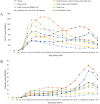Global burden and trends of self-harm from 1990 to 2021, with predictions to 2050
- PMID: 40438046
- PMCID: PMC12116644
- DOI: 10.3389/fpubh.2025.1571579
Global burden and trends of self-harm from 1990 to 2021, with predictions to 2050
Abstract
Background: Self-harm has become a major public health problem globally. Data on the burden of self-harm in this study were taken from the GBD 2021. This study aimed to quantify historical trends (1990-2021) in the global burden of self-harm across genders, age groups, and regions, and project future changes (2022-2050) through Bayesian forecasting models.
Methods: Based on the seven GBD super-regions, the burden of self-harm was analyzed by region, age, and gender from 1990 to 2021. Hierarchical statistical approach was used to predict trends in global and regional changes in the burden of self-harm, 2022-2050.
Result: In 2021, the global DALYs and death counts from self-harm were 33.5 million (95% UI: 31.3-35.8) and 746.4 thousand (95% UI: 691.8-799.8). The region with the highest number of DALYs and deaths is South Asia and the highest age-standardized rates of DALYs and mortality were in central Europe, eastern Europe, and central Asia. Globally, the burden of self-harm was higher for males than for females. DALYs rates were highest among adolescents and young adults (20-29 years), whereas mortality rates showed a predominantly age-progressive pattern with the highest burden observed in middle-aged and older populations, albeit with a modest decline in the oldest age groups. Forecasting models showed a sustained decline in the global burden of self-harm from 2022-2050.
Conclusion: The results highlight the need for policymakers to allocate resources to high-burden regions (e.g., South Asia and Eastern Europe), to implement gender- and age-specific prevention programs, and to strengthen cross-sectoral collaboration to address the underlying social determinants of self-harm. The findings call for strengthened mental health services and targeted interventions to effectively respond to and reduce the devastating impact of self-harm on individuals and the global community.
Keywords: DALYs; disease burden; global; mortality; self-harm.
Copyright © 2025 Xie, Tang, Liu, Dong and Zhang.
Conflict of interest statement
The authors declare that the research was conducted in the absence of any commercial or financial relationships that could be construed as a potential conflict of interest.
Figures




Similar articles
-
Self-harm and interpersonal violence attributable to high alcohol use in 204 countries and territories, 1990-2021: Findings from the Global Burden of Disease study 2021.Soc Sci Med. 2025 May;373:117962. doi: 10.1016/j.socscimed.2025.117962. Epub 2025 Mar 14. Soc Sci Med. 2025. PMID: 40157302
-
Global, regional, and national comparative risk assessment of 84 behavioural, environmental and occupational, and metabolic risks or clusters of risks for 195 countries and territories, 1990-2017: a systematic analysis for the Global Burden of Disease Study 2017.Lancet. 2018 Nov 10;392(10159):1923-1994. doi: 10.1016/S0140-6736(18)32225-6. Epub 2018 Nov 8. Lancet. 2018. PMID: 30496105 Free PMC article.
-
Burden of disease scenarios for 204 countries and territories, 2022-2050: a forecasting analysis for the Global Burden of Disease Study 2021.Lancet. 2024 May 18;403(10440):2204-2256. doi: 10.1016/S0140-6736(24)00685-8. Lancet. 2024. PMID: 38762325 Free PMC article.
-
Global, regional, and national burden of 12 mental disorders in 204 countries and territories, 1990-2019: a systematic analysis for the Global Burden of Disease Study 2019.Lancet Psychiatry. 2022 Feb;9(2):137-150. doi: 10.1016/S2215-0366(21)00395-3. Epub 2022 Jan 10. Lancet Psychiatry. 2022. PMID: 35026139 Free PMC article.
-
Global, regional, and national burden of asthma and atopic dermatitis, 1990-2021, and projections to 2050: a systematic analysis of the Global Burden of Disease Study 2021.Lancet Respir Med. 2025 May;13(5):425-446. doi: 10.1016/S2213-2600(25)00003-7. Epub 2025 Mar 24. Lancet Respir Med. 2025. PMID: 40147466
References
-
- Marchant A, Turner S, Balbuena L, Peters E, Williams D, Lloyd K, et al. . Self-harm presentation across healthcare settings by sex in young people: an e-cohort study using routinely collected linked healthcare data in Wales, UK. Arch Dis Child. (2020) 105:347–54. doi: 10.1136/archdischild-2019-317248, PMID: - DOI - PMC - PubMed
MeSH terms
LinkOut - more resources
Full Text Sources
Medical
Miscellaneous

